Unexpected benefits of plants and animals: Lighting, explosive detection, disaster prediction and many other great applications
For decades, people have been constantly trying to model new, modern technological inventions based on observations of the natural world. But it is also the new discoveries of nature, and the tools to 'tame' it, which have opened up many novel approaches, have a stronger potential in the field of technology, rather than just imitate, to solve the age-old problems that people are facing today.
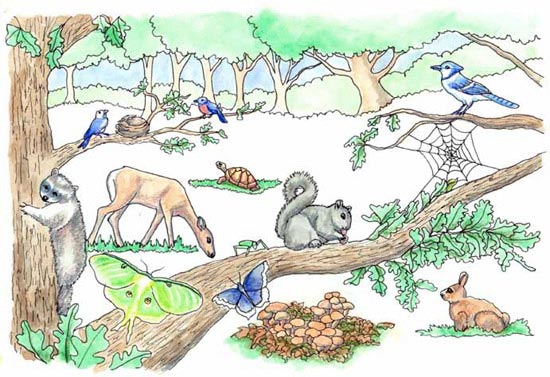 Eastern plants also possess many unexpected uses that we have not discovered
Eastern plants also possess many unexpected uses that we have not discovered
Let's come to the unexpected benefits that animals and plants can bring to people, of course not only to make food or to support labor as tradition, but in a completely new way.
- The 5 reasons why killer whales are 'cold-blooded' geniuses of the ocean
4 great applications from the combination of biology and technology
- Spinach can help detect explosives
- Without electric light bulbs, light up the city with bioluminescent technology
- The network monitors the fields made up of bees
- Turn sheep and goats into "experts" to predict natural disasters
Spinach can help detect explosives
Spinach, better known as spinach or spinach, spinach, sticky rice, and sticky rice, is an extremely nutritious plant that provides many beneficial nutrients. for human. However, few people know that this interesting vegetable is also used to detect flammable substances.
- The most expensive fish in the world, the highest record is over 71 billion a tuna
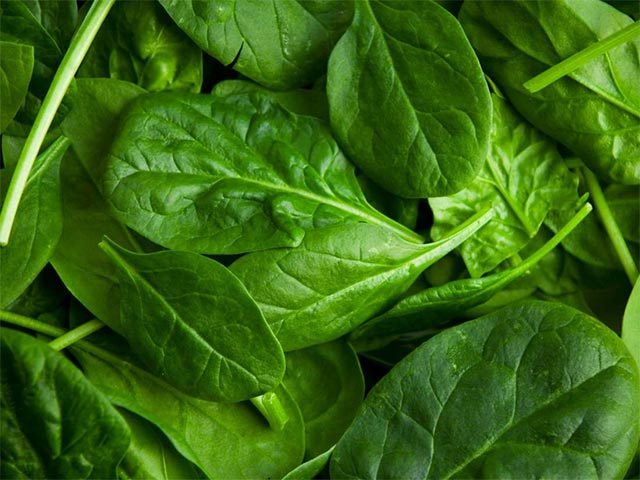 Not only for high nutritional value, spinach is also a completely natural environment "sensor"
Not only for high nutritional value, spinach is also a completely natural environment "sensor"
Indeed, technology engineers have recently discovered how to turn spinach plants into a completely natural type of environmental sensor, which can warn us about the presence of explosives, and specifically negatively affects the living environment. This is the latest innovation coming from a field that is also very new to the field of research called 'cyborg botany'. Basically, cyborg botany is a research industry related to the integration between nature and technology, based on the remarkable sensory abilities of plants to control machine systems, robots, and data supply. related to the environment and more.
Specifically in 2016, biochemist Min Hao Wong and his team at Massachusetts Institute of Technology (MIT) succeeded in finding ways to attach micro carbon nanotubes to spinach leaves through gas. giant. Any trace, chemical composition of the explosive material, whether in the minimum amount, floating in the air or groundwater, will cause the nanotubes in spinach leaves to emit fluorescence signals.
In order to receive the signal emitted from the spinach, the team used a small infrared camera to observe vegetable leaves, and connected the camera to the Raspberry Pi - a compact, inexpensive machine system - compatible. like what we find in smartphones. When the camera detects signals from vegetable leaves, it will trigger email alerts.
- The best fathers in the natural world that you may not know
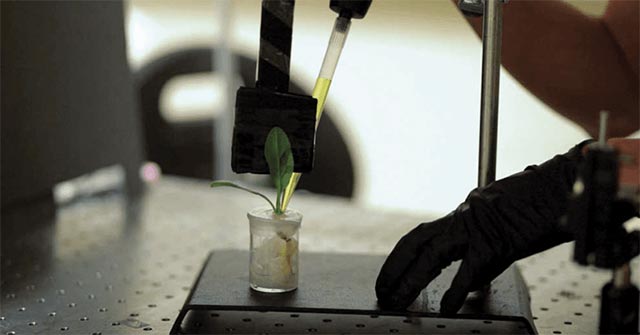 Micro carbon nanotubes are attached to spinach leaves through stomata.
Micro carbon nanotubes are attached to spinach leaves through stomata.
After studying nanotechnology on spinach, Wong's group has continued to develop a number of other applications of this technology and gained many commendable successes, especially in the agricultural sector. Plants in general are very sensitive to any changes from the environment, even the smallest, so they can support early warning of the occurrence of extreme weather conditions such as drought or pest. . before the most experienced farmer on the planet could do the same thing.
Min Hao Wong and his research group are now planning to commercialize the technology. The engineer is currently the deputy director of science of Breakthrough & Sustainable Technology for Agricultural Development (DiSTAP), a well-known agricultural technology research center in Singapore.
Plants are not inanimate as many people think, but on the contrary, they have a lot to say to us. However, the problem lies in the fact that plants communicate in the language of nature, our job is to learn to understand valuable messages from them.
- Sea salt rock 2 billion years old shows an increase in oxygen in the ancient atmosphere
Without electric light bulbs, light up the city with bioluminescent technology
Many of us are probably no stranger to the animals and plants that can glow in the wild like some squid, jellyfish, or the most familiar are the fireflies in the field. These creatures can create their own attractive light, a phenomenon known collectively as bioluminescence.
 Light comes from the transplanted E.coli bacteria of the Hawaiian squid
Light comes from the transplanted E.coli bacteria of the Hawaiian squid
Having a French designer has long paid special attention to bioluminescence, which is Sandra Rey. This curiosity about this mysterious natural light inspired her to find a way to "borrow" it from the animals' bodies and apply it in many areas of life. Sandra Rey believes that bioluminescence is a natural resource that can help people create tools that emit soft light without electricity, contributing to energy savings and environmental protection. .
Sandra Rey is currently the founder and CEO of Glowee, a relatively rare company, which is a fusion of biological simulation technology (biomimicry) with synthetic biology to produce flashlights. Bio-optical. The CEO believes that one day in the near future, her company may be able to create products that are eligible to replace conventional electric light systems, which are widely used to light roads. streets and public areas, thereby helping to reduce CO2 emissions generated during electricity generation, contributing to stabilizing global energy security in an era of climate change that is unpredictable. like nowadays.
- The researchers first obtained the volcano's "thunder"
 A sufficient amount of biological light can be used for street decoration
A sufficient amount of biological light can be used for street decoration
To produce a sufficient amount of biological light in everyday use, Glowee's technicians devised a way to 'insert' the bioluminescent gene sequence of the Hawaiian squid into the E. coli bacteria, then feed it. transplant those bacteria in a specialized environment with suitable conditions. Moreover, by programming DNA, engineers can easily control the color of the light, as well as when it is turned off and on, etc.
Of course, bacteria also need to be taken care of and fed to continue to maintain their glowing ability, so the company of Sandra Rey is currently working on more optimal methods to keep bacteria capable of glows as long as possible. At the present time, Glowee is currently holding a glowing system from E.coli bacteria (which has been transplanted with Hawaiian squid genes) that can last for 6 days, and another system that works similarly. like a glowing fish tank: 'As soon as you provide food, the bacteria will immediately create light'.
Besides the variety in color, another interesting thing that Glowee's bioluminescent system has is the ability to transform unlimited shapes, from standard street lights to window luminescent stickers. It can be seen that the potential of practical application of this technology is very large.
- Robot fish helps us experience the close-up of the ocean world
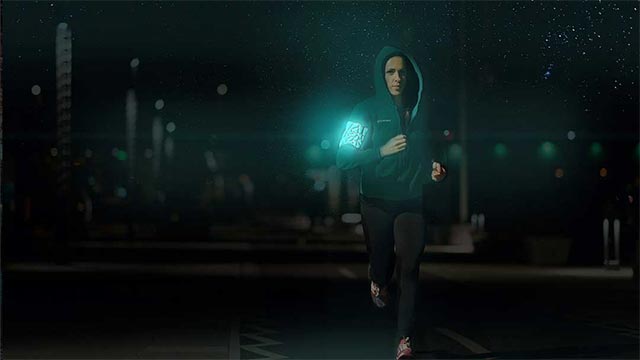 Biological glow products for flexible use in many situations
Biological glow products for flexible use in many situations
Although it is not possible to create bioluminescent systems that can exist for a long time, the limited life span limited to a few days is still applicable in events or festivals, while saving while ensuring aesthetics. Besides, this technology is also particularly suitable in areas with heavy light pollution. Stores in some French cities are forced to turn off or completely turn off the nighttime lighting system due to concerns about light pollution and inefficient energy use. Glowee's bioluminescent technology is particularly suitable for use in conventional electric lamp replacement in this case.
Finally, Sandra Rey and his colleagues are hatching a bigger plan for their bioluminescent lamp technology. 'For us, the biggest ambition is nothing more than creating a vivid, colorful glowing network on the street as soon as possible,' the CEO said.
Certainly, energy efficiency improvements that can help lighting operations are no longer a big problem for humanity. However, to light up areas where the grid still cannot reach is another story. Gradually forget about lighting these areas with electricity from generators or fire, we need bigger steps, and environmentally friendly light sources like Sandra Rey are the key to the problem.
- Scientists develop sun shields to prevent coral bleaching
The network monitors the fields made up of bees
Hard-working bees often carry a small 'backpack' to contain nectar. It is this seemingly extraordinary biology that inspires an extremely daring idea, which is to attach sensors to bees to track the position, turning this little animal into ' Unmanned drones' that farmers can use to track their fields.
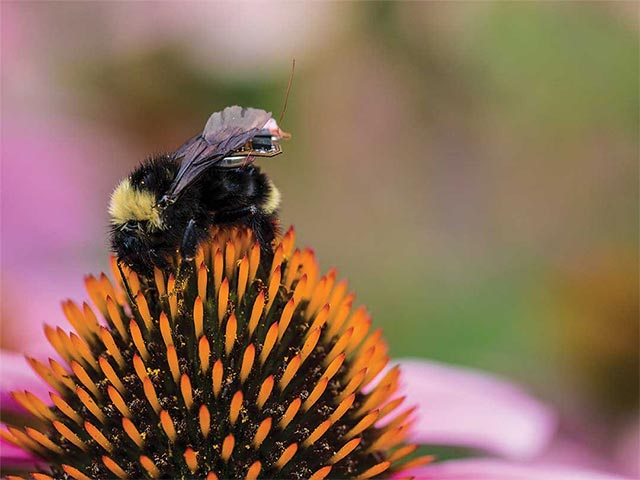 A bee was fitted with a micro sensor on its back
A bee was fitted with a micro sensor on its back
Engineers at the University of Washington, USA, have discovered that instead of using bulky devices that need to charge regularly to charge batteries, we can completely equip insects like bees, some Small but powerful device to perform similar work.
Some other researchers try to create 100% insect robots. However, the problem arises that these tiny robots have to 'wrestle' to be able to fly in chaotic conditions and are limited by the energy from a small battery.
The solution of the group of engineers at Washington University is to take advantage of the parallel benefits from real bees and technological equipment instead of trying to create a robot bee. Thanks to evolution for millions of years, insects have found a way to navigate themselves in a variety of complex conditions, and they can energize themselves.
- Natural disasters can kill insects and invertebrates
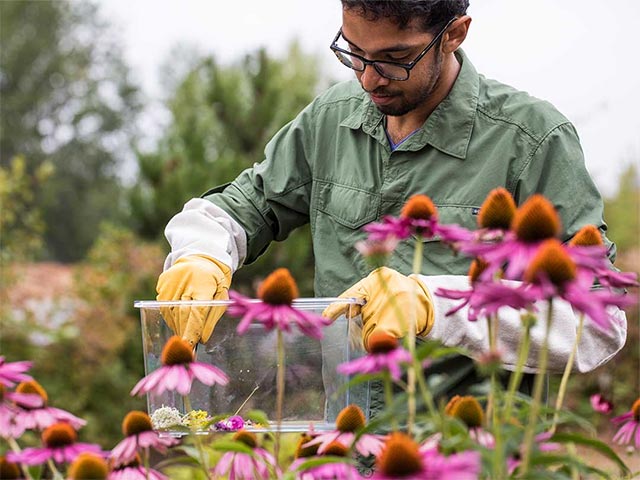 With their characteristics, bumblebees can serve as an accurate agricultural tool
With their characteristics, bumblebees can serve as an accurate agricultural tool
To make the technology serve as an accurate agricultural tool, engineers tried to integrate several devices such as sensors, data storage, signal receivers to track position and battery. Charge into a super-small system, weighs only about 102 milligrams, and attaches to their bodies. As bees fly away to carry out their daily work, the sensors will also begin to measure temperature, humidity, and the position of the bee to be monitored via radio signals to ensure seamless connection even though it is far away. When they return to the nest, the data will be uploaded to the system via a wireless connection and the battery will also be recharged.
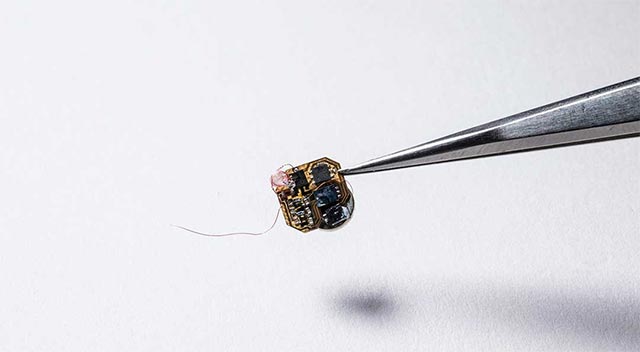 Ultra-small machinery system used to attach to the body of bees
Ultra-small machinery system used to attach to the body of bees
The team calls this technology the Living IoT. Their ambition is to create a network of sensors that can take advantage of and combine good biology with technology, creating more advanced and friendly environmental monitoring systems. Let nature be the guide!
- Norway's global seed store requires millions of dollars to upgrade because of rising temperatures
Turn sheep and goats into "experts" to predict natural disasters
More than 2 thousand years ago, Roman author Aelian once wrote about an amazing phenomenon in Greece, occurring about 5 days before a major earthquake appeared in 373 BC and caused damage. heavy, that is, almost all familiar animals such as mice, snakes, dikes, sheep and many other creatures abruptly leave town to find their escape. While cattle are kept in cages, they are like "crazy." At that time, the notion that animals possessed an 'esper power' helped them predict the natural disaster that humans did not begin to form.
- Underwater sound waves can help to alert tsunami earlier
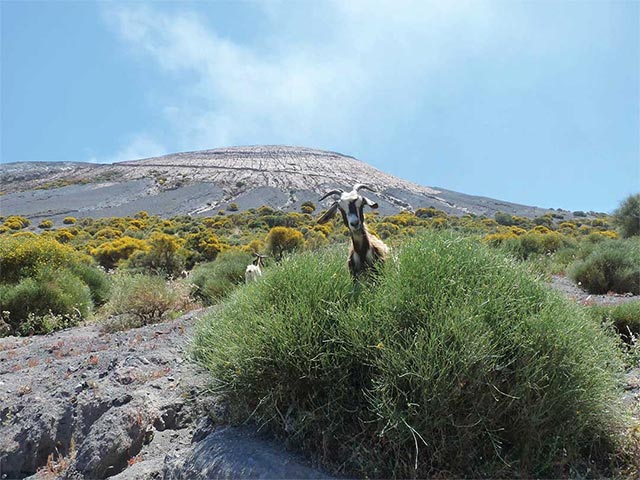 Animals, especially goats, are often very sensitive to all fluctuations and vibrations
Animals, especially goats, are often very sensitive to all fluctuations and vibrations
As a high school student, the famous zoologist Martin Wikelski translated ancient Greek and Roman texts, including the phenomenon that Aelian once mentioned. It was this that convinced him that animals could possess innate ability to perceive abnormalities in the natural environment, especially before an impending disaster.
Wikelski is currently leading a series of interesting and ambitious animal research projects, as well as how to utilize their special abilities to serve human life. Previously, he had a reputation in the scientific community for the idea of attaching GPS transceivers on some animals to collect and analyze information about their collective behavior that could be revealed. what. In a few other notable studies, Wikelski once pointed out that the presence of white storks may indicate the outbreak of a grasshopper epidemic, while the location and body temperature of the mallard is can signal the spread of avian influenza in humans.
Now his team is focusing on goats, in order to verify the notion that the animal can recognize the signs of an imminent earthquake, as well as volcanic eruptions, capital. whether or not appeared nearly 2000 years ago is really accurate. Certainly this is still a controversial idea, but perhaps collecting 24/7 data around large events can absolutely bring about scientific credibility, one way or another.
As soon as a strong earthquake rocked Norcia, Italy, in 2016, the research group of Wikelski decided to equip a number of animals raised at the farm near the epicenter of a special necklace. especially to see if they have any unusual behavior before each aftershock. Each necklace contains both GPS tracking and accelerometer. With such day and night monitoring capabilities, Wikelski and colleagues were able to observe both normal and unusual behavior of cattle, thereby analyzing and finding possible deviations that would give the desired results. .
- Asian regional mapping scientists are prone to earthquakes in the hope of mitigating natural disasters
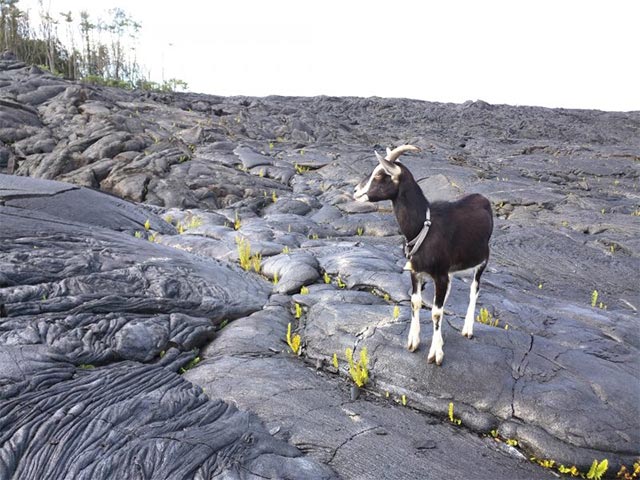 Goat species living in areas near volcanoes often show strange signs before each eruption
Goat species living in areas near volcanoes often show strange signs before each eruption
In Italy, Wikelski and his team have noted that animals' heart rhythms have an overly normal phenomenon, along with the phenomenon of 'restlessness, uneasiness' for hours before the battle. land occurs. The scientist observed that the time of 'red alert' occurred within 2 to 18 hours, depending on the distance of these organisms with the epicenter. This is the time when they appear the most unusual phenomena. This proves that the views of the ancient Romans were not unfounded.
From the promising results of the study, Wikelski is more interested in clarifying the mechanism of feeling the extreme natural phenomena of animals, which are typically sheep and goats.
If simply animals are very sensitive to all fluctuations, vibrations, seismologists can completely solve the outstanding problems in the early predicting the phenomenon of earthquakes, volcanic eruptions. by using these animals themselves. In fact, underground soil is often under great pressure before an earthquake occurs and pushes particles into small air out into the air. 'There is a change in the air, and that may be what animals can perceive,' Wikelski said.
In the future, Wikelski and the team conducted a much larger scale experiment, which was to include tracking devices for empty animal populations near active volcanic areas of the Thai Fire Ring. Binh Duong. Basically, scientists want to collect more clear data to model the behavior of different animals in nature, and determine which species possesses the ability to predict natural disasters. more sensitive, can help people.
- Review the 10 most devastating disasters in human history
Wikelski has applied for a patent for a natural disaster warning system based on a number of animals, as well as their collective unusual behavior before the disaster.
Humans are the smartest species in the world, but animals also possess a lot of 'abilities' that we cannot afford. Taking advantage of these capabilities to serve human life, while not harming animals, is a sustainable development option that needs to be replicated.
The above are just small examples of unexpected benefits that animal and plant species bring to human life. They will be even more useful if we know how to make good use of them. All for a better future!
You should read it
- Why aren't the largest animals the fastest?
- The first human being had a biological pause to extend life, literally 'switched off and on'
- Changing the biological clock makes people more susceptible to infection
- Discover the mystery of the ocean with jellyfish with electronics
- The new 3D printing technique can create delicate, small, soft objects in seconds
- The world's 10 most endangered animals
- The human brain's small biological model reveals the effects of hallucinations
- Misconceptions about biology that many people still believe in.
May be interested
- Plants feel pain when they are eaten and have a defense mechanism against it
 don't think plants are inanimate, they have intelligence. scientists have discovered that vegetables and plants sense when they are eaten by enemies and of course they do not like this.
don't think plants are inanimate, they have intelligence. scientists have discovered that vegetables and plants sense when they are eaten by enemies and of course they do not like this. - Which smartwatches and fitness trackers have fall detection?
 fall detection is useful because it can notify emergency contacts or call for help if the device registers that the wearer has fallen or experienced some kind of impact.
fall detection is useful because it can notify emergency contacts or call for help if the device registers that the wearer has fallen or experienced some kind of impact. - 12 types of ornamental plants clean the indoor air
 some ornamental plants not only help decorate your house but also absorb chemicals that pollute the air to bring a healthy living space to your family.
some ornamental plants not only help decorate your house but also absorb chemicals that pollute the air to bring a healthy living space to your family. - 10 unexpected benefits when raising a dog you may not know
 if you have a pet friend like a dog, you have a lot of reasons to thank him. if you're considering wanting a dog, take a look at the amazing benefits of raising them.
if you have a pet friend like a dog, you have a lot of reasons to thank him. if you're considering wanting a dog, take a look at the amazing benefits of raising them. - 8 great benefits of coconut water you may not know yet
 let's find out 8 great benefits of coconut water you may not know, which explains to you why it became popular below!
let's find out 8 great benefits of coconut water you may not know, which explains to you why it became popular below! - List of 24 endangered animals in the last 10 years
 the international union for conservation of nature (iucn) annually carries out the task of announcing plants and animals on the brink of extinction, in order to warn of environmental degradation.
the international union for conservation of nature (iucn) annually carries out the task of announcing plants and animals on the brink of extinction, in order to warn of environmental degradation. - 10 great benefits from eating 3 bananas a day
 eating 3 bananas a day not only provides our body with about 1500mg of potassium but also brings a host of other health benefits. join us to find out 10 great benefits of eating 3 bananas a day!
eating 3 bananas a day not only provides our body with about 1500mg of potassium but also brings a host of other health benefits. join us to find out 10 great benefits of eating 3 bananas a day! - 7 species of plants have special abilities like humans
 mustard plants and family with vegetables are often eaten by leaves. in response, they produce a special chemical that draws parasitic wasps to close the enemy immediately after the appearance of a caterpillar egg to promptly prevent the risk of being eaten.
mustard plants and family with vegetables are often eaten by leaves. in response, they produce a special chemical that draws parasitic wasps to close the enemy immediately after the appearance of a caterpillar egg to promptly prevent the risk of being eaten. - How to set up features Multilingual Text Prediction in Windows 10
 starting with windows 10 build 17093, the operating system supports up to 3 latin languages for multilingual text prediction feature. it is using the first 3 installed languages from language settings to make predictions.
starting with windows 10 build 17093, the operating system supports up to 3 latin languages for multilingual text prediction feature. it is using the first 3 installed languages from language settings to make predictions. - If the Earth swells twice, how will humans and plants and animals change?
 if our earth suddenly swells twice, will we have more space to live?
if our earth suddenly swells twice, will we have more space to live?









 The billionaire company Elon Musk successfully developed a system that helps control computers by thinking
The billionaire company Elon Musk successfully developed a system that helps control computers by thinking Mechanical keyboards using a new switch mechanism can provide durability up to 1 billion clicks
Mechanical keyboards using a new switch mechanism can provide durability up to 1 billion clicks Snapdragon 855 Plus will be a high-end chip, 'special treatment' with very noticeable improvements
Snapdragon 855 Plus will be a high-end chip, 'special treatment' with very noticeable improvements IBM registered a patent for sliding screen technology, turning smartwatch into a smartphone with just a few simple steps
IBM registered a patent for sliding screen technology, turning smartwatch into a smartphone with just a few simple steps Researchers invented a method that allows playing a puzzle game through brain waves
Researchers invented a method that allows playing a puzzle game through brain waves Google will launch Fast Share to replace Android Beam and compete with AirDrop
Google will launch Fast Share to replace Android Beam and compete with AirDrop